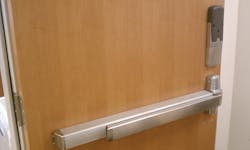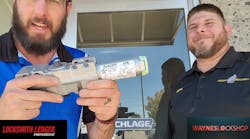The protection of life and property has always been a main focus of the locksmith profession. Often that focus has been directed on keeping the bad guys out, so to speak. Installing hardware that prevents unauthorized entry to a building or residence is an important aspect of our industry. But we are often called upon to install and service hardware that has, as its main function, the protection of the occupants of a building from the spread of fire.
A report by the National Fire Protection Association (NFPA) published in March 2011 lists the annual averages for fires in a wide variety of occupancies. For example, the average number of fires each year in “public assembly” occupancies such as stadiums, movie theaters and churches has been over 15,000 with 5 deaths and 160 injuries. Education facilities averaged more than 6,000 fires each year with 85 injuries. The report has many more occupancy types reported and the total number of fires for all types is more than 500,000 each year with more than 2,800 deaths and almost 15,000 injuries annually. The full report can be downloaded at: http://www.nfpa.org/assets/files//OS.StructureFiresOccupancy.pdf
In an effort to improve life safety in most occupancy types, recent changes to the NFPA 101 Life Safety Code (2009) have added a provision (7.2.1.15.1) that requires that all fire doors be inspected “not less than annually.” It further requires that “fire-rated door assemblies shall be inspected and tested in accordance with NFPA 80” (7.2.1.15.2).
The inspection of fire doors offers locksmiths an opportunity to provide a service which they are already very qualified to perform. Section 5.2.3.1 of NFPA 80 states; “Functional testing of fire door and window assemblies shall be performed by individuals with knowledge and understanding of the operating components of the type of door being subject to testing.” Section 5.2.1 of NFPA 80 requires that “a written record of the inspection shall be signed and kept for inspection by the Authority Having Jurisdiction (AHJ). ”
Few people are more qualified than locksmiths to perform these inspections and there are resources available to help you become even more competent when performing them.
What needs to be inspected?
Section 5.2.4.2 clearly defines what needs to be inspected and documented when it states, “As a minimum, the following items shall be verified:”
(1) No open holes or breaks exist in surfaces of either the door or frame.
(2) Glazing, vision light frames, and glazing beads are intact and securely fastened in place, if so equipped.
(3) Door, frame, hinges, hardware, and noncombustible threshold are secured, aligned, and in working order with no visible signs of damage.
(4) No parts are missing or broken.
(5) Door clearances at the door edge to the frame, on the pull side of the door, do not exceed clearances listed in 4.8.4 and 6.3.1.
(6) The self-closing device is operational, that is, the active door completely closes when operated from the full open position.
(7) If a coordinator is installed, the inactive leaf closes before active leaf.
(8) Latching hardware operates and secures the door when it is in the closed position.
(9) Auxiliary hardware items that interfere or prohibit operation are not installed on the door or frame.
(10) No field modifications to the door assembly have been performed that void the label.
(11) Gasketing and edge seals, where required, are inspected to verify their presence and integrity.
Looking at these 11 items, there is nothing there that a locksmith should not be able to verify. Resources are available online. One excellent site is http://idighardware.com/fdai/.
Documentation
The requirement to document these inspections cannot be understated. The AHJ will want to see the inspection records and may be suspicious of the validity of the inspection if the report is not clear and orderly.
Recently I attended a meeting of the California Fire Prevention Officers Association and asked the group how they felt about locksmiths or lngineers doing these inspections. Response were both pro and con in nature. One fire marshal said he was concerned that any inspection record may be “nothing more than an unqualified person signing off on a procedure.”
Another though was more positive, Sean Daugherty, Fire Inspector for the Long Beach Fire Department said: "As with any provision in the code that allows a ‘knowledgeable person’ to perform certain work, there is always a question of what that actually means for the code official. We like to see training certifications or work experience commensurate with the required task. I imagine that most AHJ's would feel very comfortable with locksmiths conducting functional tests on door assemblies."
The more thorough and professional your inspection records look, the more comfortable the local AHJ will be accepting them as meeting the requirements of NFPA 80.
The web site https://www.inspectionhelp.com/ is one site that helps with the record keeping of inspections and formats the reports in a way that should satisfy even the most skeptical code official.
One aspect that is still unknown regarding this provision of NFPA 80 is how soon and to what extent local authorities will start enforcing it. Very soon, a Fire Marshal could walks into a facility and asks for you inspection records. If you are prepared to show documentation that you have done what is required, then you will be in stronger position. Prepare yourself for this and your customers or employer will see the value of having a locksmith they can count on to be familiar with all current code requirements.
Chris Clark started in the industry in 1975 as a commercial Locksmith. He currently works for Ingersoll Rand Security Technologies in Southern California.






